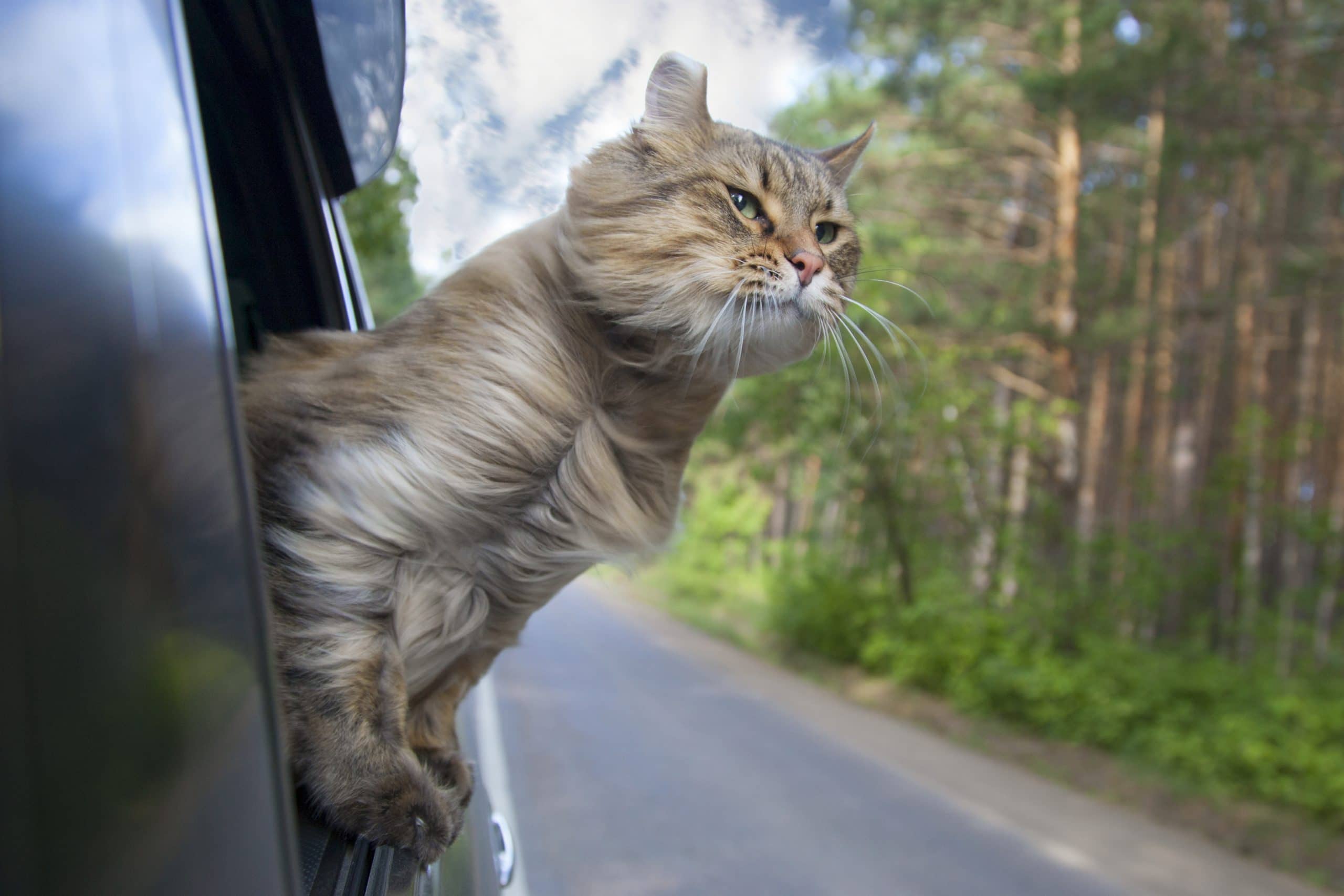A Complete Guide to Traveling with Your Cat
Contents of Article
We all need a break from reality once in a while and traveling is the perfect way to let loose and relax. When you hit the road and venture away from home, what happens to your cat? Do you leave him with a neighbor or take him to a kennel? If you hate the idea of leaving your cat behind, you’ll be glad to learn that you don’t have to! With the right preparations, traveling with your cat can be simple and enjoyable for the both of you.
Though you may love to travel, many cats do not. Many cats get nervous during car rides or they get car sick – some become stressed or overwhelmed to the point that they panic. It is entirely possible to have a safe trip with your cat, but you need to make some preparations first. Not only do you need to plan ahead in packing your bags and finding a pet-friendly hotel, but you should also condition your cat to reduce his anxiety about travel.
If you’re thinking about bringing your cat with you on your next trip, this in-depth guide is exactly what you need! We will cover some of the challenges of traveling with a cat and provide helpful tips and tricks for making the experience as hassle-free as possible. So, if you’re ready to learn the secrets to successful travel with your cat, keep reading!

Why Don’t Cats Like to Travel?
Cats are very much creatures of habit – they tend not to like anything that disrupts their routine. For most cats, riding in the car is an out-of-the-ordinary thing, so it can cause anxiety or stress. Cats also tend not to like being away from what they perceive as their territory. If you only take your cat in the car on the way to the vet, he could form a negative association with car rides as well. Though you may not like to hear it, you are probably reinforcing your cat’s fears by soothing him as he whines or cries from the back seat.
If you plan to travel with your cat, especially for any extended period of time, you may want to take some time to get him used to the car before you force him to spend an entire day in it, or longer. The first thing you need to do is invest in a high-quality travel carrier. Allowing your cat to roam freely in the car is a horrible idea. Not only could he be injured in the event of an accident, but he could panic and cause a dangerous distraction – he could also get stuck under a seat. The carrier will keep your cat safe and contained throughout the duration of the trip.
Once you have your travel carrier, line it with a soft blanket or a crate mat to keep your cat comfortable during the trip – it may help your cat to feel more comfortable if you use something he’s slept on before. Next, take some time to acclimate your cat to the carrier and to the car – you should do this over the course of at least a week before your travel date. Place the carrier inside the car then get in the car with your cat and close the door. Let your cat explore a little bit and sniff around.
To help your cat form a positive association with the car and with the crate, toss some treats into it for him to find or start feeding him his meals in the carrier. Once your cat becomes more comfortable with the car itself and with the carrier you can start taking him on short trips around the block, gradually increasing the length. It is normal for your cat to whine a little bit but don’t give in and let him out of the carrier – you also shouldn’t try to soothe him or you might end up reinforcing the idea that a car ride is something he should be afraid of. It may take some time, but eventually you can get your cat used to riding in the car and it will no longer be a stressful experience.
What Should You Bring?
You’ve already learned about the importance of a high-quality travel carrier, but there are a number of other things you should bring with you when you and your cat travel together. Here is a quick list of things to bring along:
- Copies of your cat’s medical records
- Collar and ID tags with contact information
- Current photo of your cat
- Any medications your cat needs
- Food and water bowls
- Your cat’s food and treats
- A comfy blanket or bed (for outside the carrier)
- Your cat’s favorite toys
- Supplies for cleanup (paper towels, carpet spray, etc.)
- Travel litter box with litter and scoop
Some of the things on this list may not be necessary for every trip – it is up to you to use your best judgment about what you are going to bring. Make sure to pack the essentials first, things like food, then add extra toys and other items if you still have room.
In addition to packing the items on the list above, there are a few more things you should have with you when you travel that take a bit of preparation. You never know when an accident might happen and you’ll have to take your cat to the emergency vet. When you’re away from home, however, you might not be able to find one quickly. Before you travel, take the time to look up some veterinarians and emergency clinics near your destination and along the way, just in case. You may not need it, but it is always better to be safe than sorry!
Tips for Traveling by Plane with Your Cat
When traveling with your cat by plane, there are some specific preparations you need to make and protocols you need to follow. Each airline has its own rules regarding pet travel, so shop around a little bit and be sure to read the fine print before you book your ticket. When it comes to plane travel, there are two options for your cat – the cargo hold or in the cabin. Some airlines allow pets under 20 pounds to travel in the cabin as long as their carrier can fit under the seat in front of you. If this isn’t an option, your cat might have to travel in the cargo hold.
As you shop around for flights, pay attention to the minute details. Keep in mind that some airlines only allow a certain number of pets to travel in the cabin for each flight – if you don’t book soon enough to reserve your spot, you might have to switch flights or put your cat in the cargo hold. Keep in mind as well that there may be an extra fee for your cat and that you have to have an airline-approved carrier. You will probably also need to show the airline your cat’s vaccination records – keep one copy on your person and another in the carrier itself. You should also make sure the carrier is clearly labeled with your name and contact information.
If you’re traveling by plane with your cat, you should plan to arrive at your gate at least an hour early. Some airlines will want to inspect the carrier and review your cat’s vaccination records, so leave plenty of time for this. During the 24 to 48 hours before your flight, you should start to withhold food and water. If you are traveling in the morning, don’t feed your cat the night before. Most cats can hold their bladders well, so you can still offer water up until a few hours before the flight. Just in case, however, you should place a pee pad on the bottom of your cat’s carrier and cover it with a blanket – the liquid will soak through the blanket into the pee pad, preventing your cat from sitting in urine for hours.
When you arrive at your destination, it’s a good idea to wait until the rest of the plane has disembarked so you don’t stress your cat by battling through a crowd. Do not open the carrier or take your cat out until you actually arrive at your final destination. Even then, however, it’s not a bad idea to let your cat rest for an hour or so to calm down. If your cat seems extremely agitated, he may need some extra time. You should also be very careful when taking him out of the carrier because he could spook – consider putting him in a harness, just in case.
Traveling by Car with Your Cat
You already understand the importance of a good travel carrier and you’ve learned how to acclimate your cat to the carrier and to the car. Now it is time to learn the specifics of actually traveling with your cat by car. Set up your cat’s carrier in the backseat so, if there is an accident, he is protected from the airbags. If you have a carrier that is specifically designed for travel it might include an option to secure it in place with a seatbelt – use this option if it is available. If it isn’t, you can try placing some of your luggage on either side of the carrier to keep it from tipping, just be sure that the luggage won’t fall over onto the carrier.
As you hit the road, be prepared to take frequent breaks. You don’t necessarily need to take your cat out of the carrier during these breaks, but it will give your cat a chance to rest a little bit. If you are able to do so safely, you can let your cat out of the carrier in the car or outside the car if he has a harness or leash. You can give your cat the option to use the litter box during breaks, but he is unlikely to use it. If you have to leave your cat in the car, always leave a window cracked even if it doesn’t feel hot out. If you are traveling in the spring or summer, try to park in the shade or have one person stay in the car with the air conditioning running if you need to use the restroom or get some food.
During your travel, you can give your cat some water during breaks, but wait to feed him until you’ve arrived. Keep in mind that some cats are finicky about the taste of water, so it might be a good idea to bring a supply from home. If you are traveling during the summer, bring some ice packs and a cooler so you can give your cat some cold water. The ice packs will also come in handy if the air conditioning in your car stops working – you can place them under the blanket in your cat’s carrier to keep him cool. Conversely, if you are traveling in winter you should bring extra blankets to keep your cat warm.
How to Find a Cat-Friendly Place to Stay
Though it may be a little stressful for the both of you, the actual travel portion of your trip may be the easiest part – what may be difficult is finding a cat-friendly place to stay. More and more hotels are becoming pet-friendly, though many hotels allow dogs but not cats. If you’re planning to stay in a hotel, you should do some research to find one near your final destination that accepts cats. This may require you to do a little research and you’ll have to look into the individual pet policies for each hotel.
To help you find a cat-friendly hotel, try websites like BringFido.com and Petfriendlytravel.com, or you can search by pet-friendly hotels on sites like Expedia and TripAdvisor. Here are some of the top pet-friendly hotel chains:
- Four Seasons Hotel/Resorts
- La Quinta
- Kimpton Hotels
- Ace Hotel
- Best Western
- Lowes Hotel/Resorts
- Fairmont Hotel/Resorts
- Hotel Indigo
- Red Roof Inn
- Ritz Carlton
As you do your research, pay attention to the rules and regulations that accompany each pet-friendly hotel’s pet policy. You should also check to see what kind of pet-friendly amenities the hotel offers such as hardwood floors for easy cleaning or a welcome bag with treats for your cat. It is also important to keep in mind that even though hotels provide cleaning services, it is still your responsibility to clean up after your cat if he has an accident or makes a mess. You should also be prepared to pay for damages if your cat claws something. Keeping your cat in the bathroom is a good way to prevent damage.
Once you have found a cat-friendly hotel, you can start taking steps to help your cat settle in. Hopefully you have brought with you a few familiar items from home to help your cat deal with being in an unfamiliar situation. The best idea is to set up shop in the bathroom for your cat – most hotel doors open right into the room and you don’t want to risk your cat escaping. Place your cat’s carrier in the bathroom and leave the door open so he can retreat to the carrier if he likes. Set up your cat’s food and water bowls then place the litter box in the bathtub to minimize mess and to create some separation from your cat’s eating area.
Staying at a hotel can be stressful for your cat, so there are a few things you should keep in mind. If you choose not to keep your cat in the bathroom, you’ll need to be very careful about knowing where your cat is at all times so he doesn’t bolt out the door. Most cats will hide when they are in an unfamiliar location, so be prepared to spend some time searching for your cat if you decide to move him to the bathroom overnight. Keeping some tasty treats and a fresh can of wet food may help to entice your cat out of hiding. When you are just resting in the hotel room, however, you should give your cat some time and space to rest as well – don’t force him to come out if he doesn’t want to.
Other Tips for Traveling with Your Cat
Before you and your cat head out on the open road, you should talk to your veterinarian. Not only do you want to make sure that your cat is healthy enough for travel, but your vet might be able to give you advice for how to keep your cat calm during the trip. If your cat gets car sick, or if travel is extremely stressful for him, your vet might suggest sedation. There are different medication options out there, so talk to your vet about the one that is right for your pet. When it comes time to travel, give your cat the medication ahead of time so he is calm (or asleep) when it comes time to put him in the car. You may also want to do a pre-travel trial to make sure your cat responds to the medication – some don’t.
During travel, try to limit your cat’s interaction with strangers unless he is particularly good with people. Travel can be stressful for cats and adding the anxiety of being around unfamiliar people could make things worse. If you have to leave your cat alone in the hotel room, make sure he is safe and secure – you might also leave him with an item of your clothing or something familiar from home. Though it may be challenging to do so, you should also try to stick to your normal routine as much as possible while you’re away from home. Feed your cat at the usual times and don’t make any changes to his diet. If your cat seems to not be adjusting well, you might want to take him to a local vet for a checkup, just in case.
Safe Alternatives for Leaving Your Cat at Home
In the event that traveling with your cat is not a practical option, you should consider the alternatives before making your choice. The best option is probably to enlist a friend or hire a pet sitter to come to the house and feed your cat. Though your cat may become a little nervous about your absence, he will be much happier at home than in a boarding facility. The great thing about cats is that they don’t need to be walked everyday like dogs, so having someone check in once a day for feeding is perfectly fine. If you really want to make sure your cat is taken care of, you could hire someone to come and stay at the house throughout the duration of your absence.
If you don’t like the idea of leaving your cat alone at home, you can think about having a friend or family member watch him in their own home. It could be stressful for your cat to be kept in an unfamiliar place, but a few days won’t hurt. Think of a kennel or boarding facility as a last resort. These facilities are fine for dogs, but they can be extremely stressful for cats. Not only is your cat likely to be nervous in an unfamiliar place, but he may become stressed by dogs barking and by being kept in a small, confined area. Some boarding facilities are better than others, however, so if you must use this option, look for one that is particularly cat-friendly.
No cat owner likes to leave his cat at home, though sometimes it is the best option. If you have the chance to travel with your cat, however, by all means take advantage! Enjoying a trip together could be a great bonding experience for you and your cat – just be sure to follow the tips and tricks provided in this article to ensure a safe and enjoyable experience for everyone involved.







